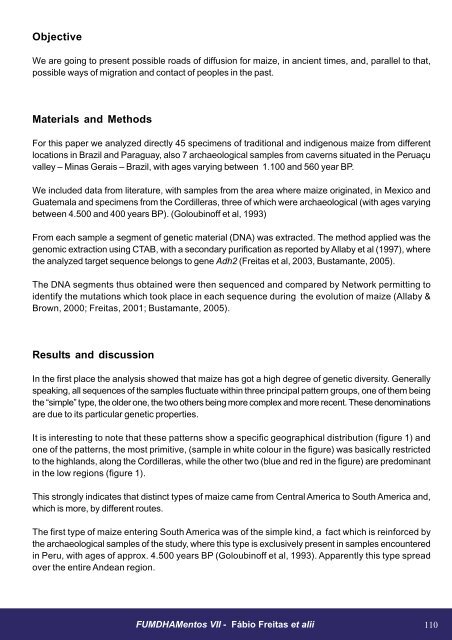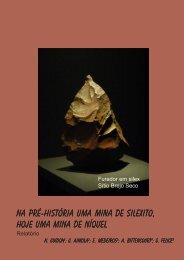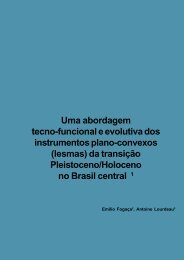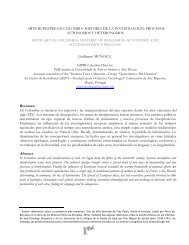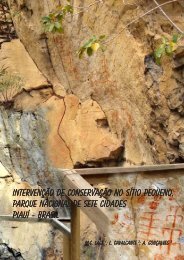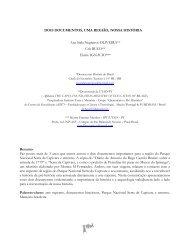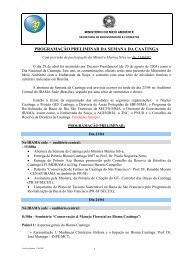O Homem seguiu as plantas ou as plantas seguiram o Homem?
O Homem seguiu as plantas ou as plantas seguiram o Homem?
O Homem seguiu as plantas ou as plantas seguiram o Homem?
- No tags were found...
You also want an ePaper? Increase the reach of your titles
YUMPU automatically turns print PDFs into web optimized ePapers that Google loves.
Objective<br />
We are going to present possible roads of diffusion for maize, in ancient times, and, parallel to that,<br />
possible ways of migration and contact of peoples in the p<strong>as</strong>t.<br />
Materials and Methods<br />
For this paper we analyzed directly 45 specimens of traditional and indigen<strong>ou</strong>s maize from different<br />
locations in Brazil and Paraguay, also 7 archaeological samples from caverns situated in the Peruaçu<br />
valley – Min<strong>as</strong> Gerais – Brazil, with ages varying between 1.100 and 560 year BP.<br />
We included data from literature, with samples from the area where maize originated, in Mexico and<br />
Guatemala and specimens from the Cordiller<strong>as</strong>, three of which were archaeological (with ages varying<br />
between 4.500 and 400 years BP). (Gol<strong>ou</strong>binoff et al, 1993)<br />
From each sample a segment of genetic material (DNA) w<strong>as</strong> extracted. The method applied w<strong>as</strong> the<br />
genomic extraction using CTAB, with a secondary purification <strong>as</strong> reported by Allaby et al (1997), where<br />
the analyzed target sequence belongs to gene Adh2 (Freit<strong>as</strong> et al, 2003, Bustamante, 2005).<br />
The DNA segments thus obtained were then sequenced and compared by Network permitting to<br />
identify the mutations which took place in each sequence during the evolution of maize (Allaby &<br />
Brown, 2000; Freit<strong>as</strong>, 2001; Bustamante, 2005).<br />
Results and discussion<br />
In the first place the analysis showed that maize h<strong>as</strong> got a high degree of genetic diversity. Generally<br />
speaking, all sequences of the samples fluctuate within three principal pattern gr<strong>ou</strong>ps, one of them being<br />
the “simple” type, the older one, the two others being more complex and more recent. These denominations<br />
are due to its particular genetic properties.<br />
It is interesting to note that these patterns show a specific geographical distribution (figure 1) and<br />
one of the patterns, the most primitive, (sample in white col<strong>ou</strong>r in the figure) w<strong>as</strong> b<strong>as</strong>ically restricted<br />
to the highlands, along the Cordiller<strong>as</strong>, while the other two (blue and red in the figure) are predominant<br />
in the low regions (figure 1).<br />
This strongly indicates that distinct types of maize came from Central America to S<strong>ou</strong>th America and,<br />
which is more, by different r<strong>ou</strong>tes.<br />
The first type of maize entering S<strong>ou</strong>th America w<strong>as</strong> of the simple kind, a fact which is reinforced by<br />
the archaeological samples of the study, where this type is exclusively present in samples enc<strong>ou</strong>ntered<br />
in Peru, with ages of approx. 4.500 years BP (Gol<strong>ou</strong>binoff et al, 1993). Apparently this type spread<br />
over the entire Andean region.<br />
FUMDHAMentos VII - Fábio Freit<strong>as</strong> et alii 110


